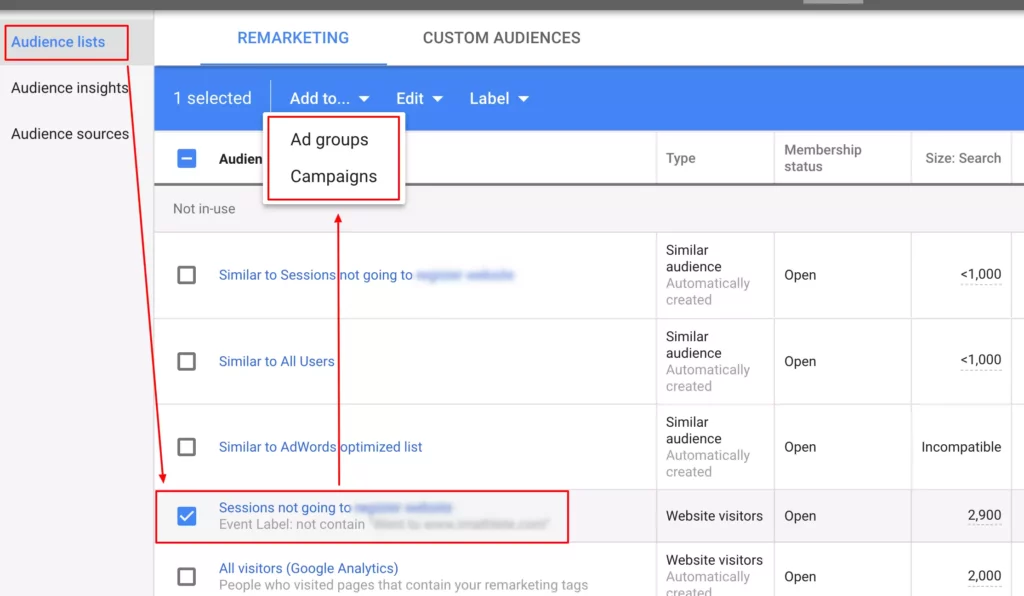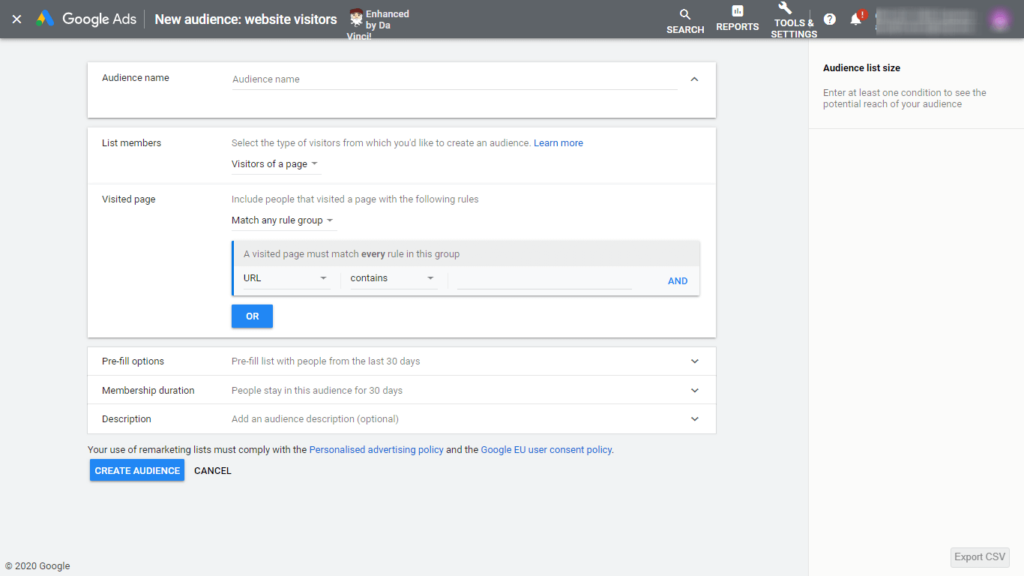Post map
ToggleIf you’re running Google Ads without leveraging remarketing, you’re missing out on the opportunity to enhance online visibility and conversion rates. Remarketing allows you to target ads to individuals who have previously visited your website, increasing the chances of conversion and delivering quick results at a low cost. In today’s article, Optimal FB will share how to create remarketing list in Google ads. Stay tuned!
What is a remarketing list in Google Ads?
RLSA, short for Remarketing Lists for Search Ads, is a feature of Google Ads that allows you to customize search ad campaigns for individuals who have viewed or interacted with your website or app in the past.
With RLSA, you can adjust bids, create ads, or expand relevant keywords for these visitors when they are searching on Google. This helps you reach the most valuable potential customers when they are searching on Google.
RLSA is available when users search through Google or Google partner websites. Remarketing lists for Google Ads require a minimum of 1000 cookies to utilize the feature. Membership duration for these lists is limited to 540 days. You can use data sources such as remarketing lists or a list of customer-matching email addresses.

How does the Google Ads remarketing list work?
Remarketing lists in Google Ads operate by using cookies to track users who visit your website. When these users leave your website and continue to use Google, your ads are more likely to appear in their search results. This allows you to connect with target audiences even after they have left your website.
RLSA audiences are created by adding a code snippet (also known as a tag) to your website. This tag automatically adds your audience to a specific list based on their actions on your website.
After placing the tag, you set bids on these segments and add them to your marketing campaigns. Over time, these audiences search on Google or other websites in the Google Display Network using specific keywords. They may then see customized ads based on their previous browsing and interaction activities on your website.
Benefits of using the remarketing list in Google ads
Using remarketing lists in Google search ads gives advertisers the ability to reconnect with past website visitors across the search network. At the same time, it brings many benefits to businesses as follows:
Personalized advertising content
By allowing advertisers to create highly targeted ads specifically to qualified leads who have previously interacted with their website. You can then adjust your ads based on the products and services your target audience previously viewed on the website. This helps increase ad relevance and increase target customer attention.
Bid control
Advertisers can set bid adjustments for specific audience segments within RLSA campaigns. At that time, they can control bids to prioritize allocating more budget to potential audiences with higher conversion rates to optimize advertising costs most effectively.
Aim accurately
Remarketing lists for search ads allow advertisers to target specific audience segments based on pages visited or actions taken on the website. This precise targeting helps advertisers reach users who are more likely to convert.
By tailoring your ad content to your target audience’s previous interactions. RLSA campaigns will deliver targeted ads to more relevant audiences. Then the relevance of the ad is improved and the quality score is raised. This results in better placement of ads, increased click-through rates, and decreased cost per click.
Focus on high-value audiences
Advertisers can focus on high-value target audience segments through bid adjustments and smart targeting strategies, increasing conversions. Focusing on these audiences helps maximize return on investment (ROI) for Google advertising campaigns.
Wide audience reach
With cross-device targeting, RLSA campaigns allow advertisers to reconnect with users who visited their website on one device and continued to engage on another. This increases your chances of reaching users wherever they are in their purchasing journey. This way you can continuously engage with them and maximize your return on investment (ROI).
How to set up a remarketing list in Google ads
Create a new audience segment
First, log in to your Google Ads account and click the wrench icon. In the Shared Library, click on Audience Manager. Then, click on the blue plus icon to create a new audience. Next, select Website visitors or any other option depending on where you have installed the remarketing tag. Then, click on the Website URL and name your audience segment.
Edit audience segment
After creating the audience segment, go to your Search campaign in Google Ads. Then, click on your ad group and select Audiences in the left sidebar. Click on Edit audience segment. Now, you have two options: Targeting or Observation.
With the Targeting option, your ads will only be shown to the selected audience segments and the keywords you bid on. With the Observation option, this setting will only show data about those audience segments but still allow ads to be shown to other users outside of those segments if they match the keywords you bid on.
Add a remarketing tag to your website
To create a Google Ads remarketing tag, go to Google Ads Manager, click Tools, select Audience Management Tools, and then click Audience Sources. Next, click Details in the Google Ads card then click and Set up tag to create a remarketing tag. Now expand the Google Ads tag, scroll down, and select Use Tag Manager.
Next, copy the conversion ID and go to Tag Manager. Select New Tag, click Tag Configuration, and choose Google Ads Remarketing. Then, enter your Google Ads conversion ID, click on Activate, select the tag activation time, and click Save. Enable the conversion linker and preview and publish.
The remarketing tag must be added to every page on your website. This tag allows Google to add each website visitor to your remarketing list.
Add remarketing lists to current campaigns and ad groups
Once you have created a remarketing list, you can add it to an ad group or a current campaign targeting the Search Network. Remarketing lists are collections of website visitors or app users gathered through code snippets added to your website or app. Depending on your goals, create the necessary remarketing lists and select the list duration.

Tips for optimizing remarketing lists for Google Ads
In addition to knowing how to set up remarketing lists in Google Ads, you should keep the following tips in mind to improve the performance of your ad campaigns:
When starting to create remarketing lists for search ads, understand the past behavior of your audience on your website. Collect user data and analyze the data you have collected for each segment to understand their specific needs, preferences, and behaviors.
Create relevant ads for each targeted segment that directly address the needs and preferences of the target audience. This includes using different messages, images, or calls to action depending on the segment. The goal is to make the ads personalized and relevant to the users.
For underperforming targeted audience segments, consider lowering your bid and improving the ad quality and landing page to improve the performance of your Google Ads campaign.
Use negative keywords to improve the performance of your Google Ads campaign by ensuring that your ads only appear in relevant searches. You can add them to your campaign or ad group in Google Ads.
Long-tail keywords have low competition and are specific phrases with a high conversion rate. RLSA targets the most qualified users with a higher intent to purchase. So, bid on long-tail keywords targeting your most qualified website visitors.
Regularly monitor the performance of your keywords in Google Ads by using performance reports to track metrics such as click-through rate, conversion rate, cost per click, ROAS, etc. Based on performance tracking, continuously optimize your keywords and adjust your bidding strategy accordingly.
Businesses can connect with their previously engaged target audience by setting up remarketing lists in Google Ads with search ads to increase conversion rates. Hopefully, this information will be helpful to you in implementing effective Google Ads campaigns.
Contact Info
Information about “remarketing list in Google ads” hopes to provide you with additional necessary knowledge. At optimal FB, there is a team of highly qualified and experienced staff and experts who will provide buy facebook ad account as well as support when you run Facebook ads. Contact us via phone number: +84 564 104 104.
Frequently Asked Questions
The following are the minimum size requirements for remarketing lists for each type of ad on Google:
Search ads: Minimum of 1000 users.
Display ads: Minimum of 100 ad users.
Video ads: Minimum of 1000 cookies.
Shopping ads: Minimum of 100 active product IDs to create a remarketing list for shopping ads.
Although remarketing lists for Google Ads have been used to target website visitors in the past, they are also effective in attracting new customers.
By using remarketing lists in Google Search Ads with appropriate targeting options, advertisers can expand their reach to users who share characteristics with their current customers.


